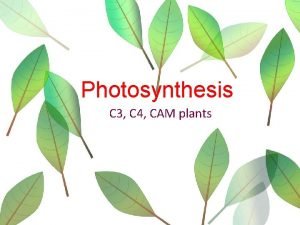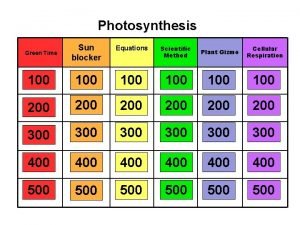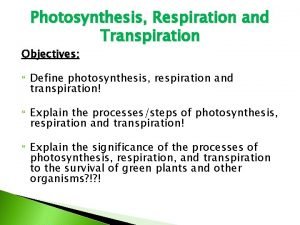Photosynthesis C 3 C 4 CAM plants Definition









- Slides: 9

Photosynthesis C 3, C 4, CAM plants

Definition • C 3 plants: all of carbon fixation and photosynthesis happens in mesophyll cells just on the surface of the leaf. • C 4 plants: carbon fixation and photosynthesis split between the mesophyll cells and bundle sheath cells. • CAM (Crassulacean acid metabolism)plants: photosynthesis takes place in the mesophyll cells, but carbon fixation (and opening of stomata) takes place at night and the Calvin cycle happens during the day.

C 3 Plants • Called C 3 because the CO 2 is first incorporated into a 3 -carbon compound. • Stomata are open during the day. • RUBISCO, the enzyme involved in photosynthesis, is also the enzyme involved in the uptake of CO 2. • Photosynthesis takes place throughout the leaf. • Most plants are C 3.

C 4 Plants • Called C 4 because the CO 2 is first incorporated into a 4 -carbon compound. • Stomata are open during the day. • Uses PEP Carboxylase for the enzyme involved in the uptake of CO 2. This enzyme allows CO 2 to be taken into the plant very quickly, and then it "delivers" the CO 2 directly to RUBISCO for photsynthesis. • Photosynthesis takes place in inner cells (requires special anatomy called Kranz Anatomy) • C 4 plants include several thousand species in at least 19 plant families. Example: fourwing saltbush pictured here, corn, and many of our summer annual plants.

C 4 Pathway

C 4 cycle

CAM Plants • Called CAM after the plant family in which it was first found (Crassulaceae) and because the CO 2 is stored in the form of an acid before use in photosynthesis. • Stomata open at night. • CAM plants include many succulents such as cactuses and agaves and also some orchids and bromeliads Cactus Orchids Bromeliads Agaves

CAM Pathway

Differences C 3 CO 2 acceptor is 5 c RUBP C 4 CO 2 acceptor is 3 c PEP CO 2 fixing enzyme is RUBP carboxylase CO 2 fixing enzyme is PEP carboxylase First product of photosynthesis is PGA (3 c) First product of photosynthesis is oxaloacetic acid (4 c) CO 2 fixation occurs once only CO 2 fixation twice – Kranz anatomy

















